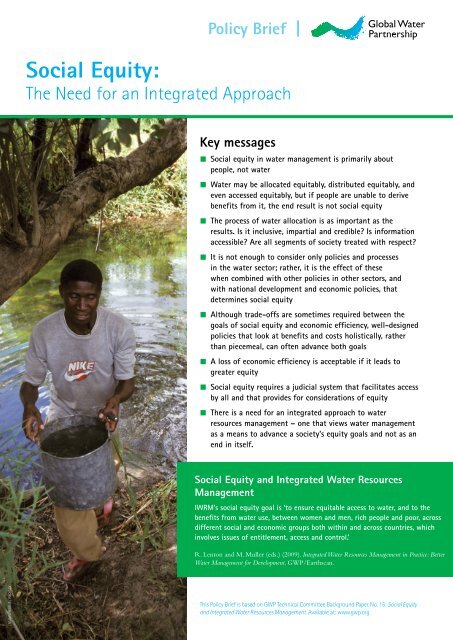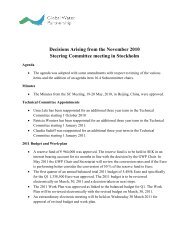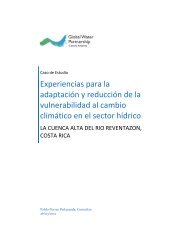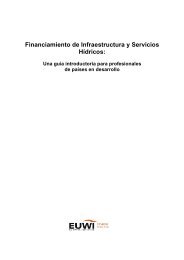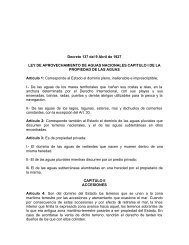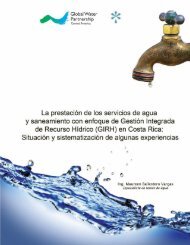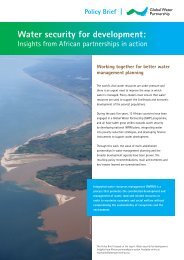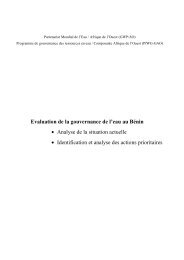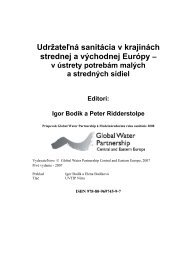Policy Brief | Social Equity - Global Water Partnership
Policy Brief | Social Equity - Global Water Partnership
Policy Brief | Social Equity - Global Water Partnership
You also want an ePaper? Increase the reach of your titles
YUMPU automatically turns print PDFs into web optimized ePapers that Google loves.
2 <strong>Policy</strong> <strong>Brief</strong> | <strong>Social</strong> <strong>Equity</strong>: The Need for an Integrated Approach<strong>Social</strong> equity, economic efficiency and environmental sustainabilityconstitute the three pillars of Integrated <strong>Water</strong> ResourcesManagement (IWRM). <strong>Equity</strong> features frequently in arguments thatpromote, or object to, reforms in the water sector. It also featureshigh on the agenda in the fight against poverty.<strong>Equity</strong> is, however, multi-dimensional. Different fields define itdifferently, and it has remained a vague concept, making it difficultfor policy makers to clarify the relationship between water and socialequity in their national or local context. As a result, inequitiesabound – sometimes glaring, spurring protest at national or globallevel, and sometimes hidden and silent, left to play out their harmfuleffects on people’s daily lives – unnoticed by the wider world.To resolve these, the relationship between water management andsocial equity should be analysed in a local context and tackledusing an integrated approach. This brief provides an analyticalframework that policy-makers and water professionals can use toclarify and resolve social equity issues in water management.To achieve social equity in water management requires recognisingthe vast range of benefits and beneficiaries associated withit, because direct benefits and beneficiaries reflect only a smallpart of the real results of water management. Besides people whobenefit directly from use of the resource (irrigation, drinking water,hydroelectric energy, etc.), or are affected by the impacts of its use(return flows, pollution, etc.), we should consider those who benefitfrom its universal access as a public good (recreation, navigation,environmental services, etc.); those who benefit from State actionsor services that are funded by resources obtained from waterrelatedeconomic activity; and those who benefit indirectly fromthese activities due to their participation in the productive process(employments, payments, productive chains with other sectors). First things first: Basic needs and ethicalprinciplesSocieties tend to set minimum standards that are supposed to governpeople’s access to goods and services. For indispensable goods likewater, these standards are discussed in the context of human rights.<strong>Water</strong> policies must take into account the provision of water to:• Meet basic human needs, such as quenching thirst, keeping clean,and cooking food• Observe and protect cultural and religious values, especiallyamong indigenous peoples• Ensure food security at a family, community or national level(water for crops and livestock)• Maintain a healthy human environment – for example, a cleanhome, clean city streets,• Preserve the environment, ecosystem services and biodiversity• Enhance the livelihoods of local populations.If these needs are to be balanced and met fairly, in ways agreedby local communities, policy-makers need to define criteria andstandards, and move on to design polices that allocate wateraccordingly. Throughout the policy process, consultation with localcommunities is essential. Allocation of water: Acceptable andunacceptable trade-offsThe current widely accepted view is that water resources shouldfall under the State, which should be responsible for controlling,regulating and allocating water resources. However, assessing theeconomic efficiency of different allocation systems needs to gobeyond strictly economic criteria – such as production value perunit and opportunity cost – to include criteria such as flexibility,
<strong>Policy</strong> <strong>Brief</strong> | <strong>Social</strong> <strong>Equity</strong>: The Need for an Integrated Approach 3legal security, predictability of supplies, equitable distribution, publicacceptance, political systems and their effects, efficacy in meetingsocial and environmental objectives, and administrative feasibility.An assessment by economists (Dinar et al, 1997) of four allocationsystems – marginal cost pricing, public allocation, user-managedallocation and water markets – came to the conclusion that thereis no one type of allocation/reallocation that is best in everycontext; each presents advantages and disadvantages. <strong>Equity</strong> mustbe evaluated in the light of historical processes as well as currentoutcomes. Systems need to be relatively stable – rules of the gamecannot constantly change to level out the playing field – so a certainamount of inequality may have to be accepted, at least for a while.Different combinations of water allocation policies, water servicespolicies and general policies yield outcomes with different relativelevels of social equity and economic efficiency:<strong>Social</strong> equityWRPWSPOWRPEPABEPWSPWRP: <strong>Water</strong> Resources PoliciesWSP: <strong>Water</strong> Services PoliciesEP: Exogenous PoliciesEconomic efficiencyIn the diagram, point O represents the initial situation. The arrowsto the second points illustrate contrasting outcomes in terms of thebalance between equity and economic efficiency, using two differentapproaches to the allocation process. The third points show the samebalance, once water services policies are added, while the fourthpoints (A and B) show the final outcome, once the effects of widereconomic policies outside the water sector are considered. Clearly,trade-offs are sometimes required between the two goals of socialequity and economic efficiency. However, well-designed policies thatlook at benefits and costs holistically, rather than piecemeal, canoften advance both goals simultaneously.In water resources management, there is relatively little scope fortrade-offs, which should not be considered where:• Uses are associated with basic human demands and minimumrequirements• Uses are not beneficial, for example, those that are wasteful,harmful or unsustainable, according to defined water resourcedevelopment strategy or goals. These uses should be eliminated• Losses in equity do not contribute to greater economic benefits(lose-lose)• Gains for different groups also benefit the poorest(win-win). <strong>Policy</strong> areas influencing social equityoutcomes<strong>Water</strong>-related activities take place in three different, but related,institutional and management spaces:• The water sector• Other related sectors, such as agriculture• General social and economic frameworks, such as povertyalleviation strategies.Other sectors(agriculture etc.)<strong>Water</strong> sector<strong>Social</strong>equityNational framework(State’s role,macroeconomy etc.)<strong>Social</strong> equity pursued only through water institutions is notsufficient to guarantee equitable results. <strong>Equity</strong> in water resourcesmanagement will not solve broader equity problems, such as landtenure, that have their roots in different aspects and at differentlevels of society. In other words, equity in allocations, uses andbenefits of water will be influenced by equity in society as a whole. How do we assess equity in watermanagement?<strong>Social</strong> equity vis-á-vis water must be understood in the contextof equity for society as a whole, to be enjoyed by people, in allits dimensions, and not just as water users. Six general principlesoffer a framework for analysing and promoting equity in watermanagement. The framework should:1. Focus on satisfying the basic needs and rights of everyone,including all groups however poor or marginalised2. Consider all the benefits derived from water (that is, indirectbenefits, such as enjoyment of biodiversity sustainedby water; and direct benefits, such as domestic use fordrinking, cooking or cleaning)3. Pay attention to decision-making processes, ensuring thatthese encompass equal opportunities, fair play and justiceas fundamental components4. Prioritise the needs and principles recognised as basic andethical by society5. Investigate current situations and their dynamics accordingto the historical contexts that have shaped them6. Accept that, sometimes, trade-offs against economicefficiency are necessary.
4 <strong>Policy</strong> <strong>Brief</strong> | <strong>Social</strong> <strong>Equity</strong>: The Need for an Integrated Approach <strong>Policy</strong> recommendations:The case for an integrated view<strong>Social</strong> equity through IWRM is a challenge for society as awhole, not just the water sector. In addition to the watersector’s policies and institutions, general ones that relate to,or influence, water management should also be considered.A multi-focus approach of this kind is particularly importantwhere water shortage constitutes a major obstacle to thefulfilment of national goals of food and energy security. Why is equity so elusive?In light of this criteria, it is clear why equity in watermanagement is so elusive. <strong>Water</strong> management is oftendelinked from the other factors that make a society moreor less equitable. It has to be understood that socialequity in water institutions alone cannot guaranteesocially equitable results, and equity in water resourcesmanagement cannot solve problems that have their rootselsewhere.Obstacles to equitable processesFactors that compromise fair decision-making and triggercomplaints from water users include:• Nominal presence or actual absence of effectiveinstitutional systems for delivering social equity• Unequal access to, and use of, information due tolack of:• Effective communication tools and processes• Training for stakeholders in the proper use ofthe valid legal and institutional system and itsguarantees• Specialised technical knowledge, which is oftencouched in language unfamiliar to participants• Corruption and lack of transparency: those withmoney and political clout win the day• Discrimination (due to gender, social, racial andpolitical differences)• Difficulties in organising collective action.Specifically, policy makers and analysts should:• Formulate policies that allow simultaneous progresstowards the goals of social equity and economic efficiency• Develop programmes that can increase economicefficiency in the weakest sectors• Use public instruments (for example, taxes and subsidies)to redistribute income, so that benefits are transferredtowards weaker sectors• Ensure that the State’s legal and macro-economic policyframework promotes the equitable allocation of benefits aswell as the control or repayment of costs. This is especiallyimportant where water resources development requires largeinvestments• Set up national and local institutions to ensure theeffective participation of all interested groups inwater-related decision-making. This will require expertknowledge of both local environments and the people(s)associated with them• Recognise initial inequality of different social groups,which leads to different levels of benefits and accessto benefits, and design programmes to overcome it. Insome cases this may mean the application of subsidies onbehalf of poorer sectors• Support negotiation between stakeholders by conductingresearch and providing data that indicate the impacts ofdifferent management alternatives• Enlist technical support to reduce the productivity gapin weaker sectors, especially agriculture, and to minimisetrade-offs between equity and efficiency• Promote other sector policies, and general economic andsocial policies, that complement equity-oriented watersector policies.Produced by Green Ink Ltd (www.greenink.co.uk)The <strong>Global</strong> <strong>Water</strong> <strong>Partnership</strong> is an intergovernmental organisation of 13 Regional <strong>Water</strong> <strong>Partnership</strong>s, 80 Country <strong>Water</strong> <strong>Partnership</strong>s and morethan 2,500 Partner Organisations in 161 countries. Our vision is a water secure world. Our mission is to support the sustainable developmentand management of water resources at all levels through Integrated <strong>Water</strong> Resources Management (IWRM). IWRM is a process that promotes thecoordinated development and management of water, land and related resources in order to maximise economic and social welfare in an equitablemanner, without compromising the sustainability of vital ecosystems and the environment.<strong>Global</strong> <strong>Water</strong> <strong>Partnership</strong><strong>Global</strong> SecretariatDrottninggatan 33SE-111 51 StockholmSwedenwww.gwp.org, www.gwptoolbox.orgFebruary 2012


